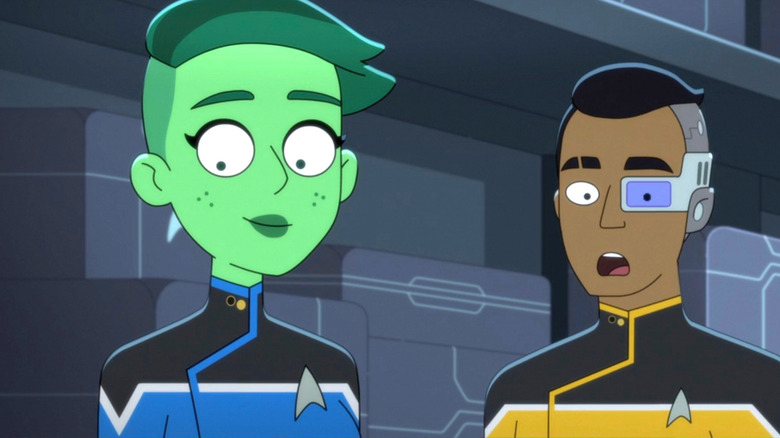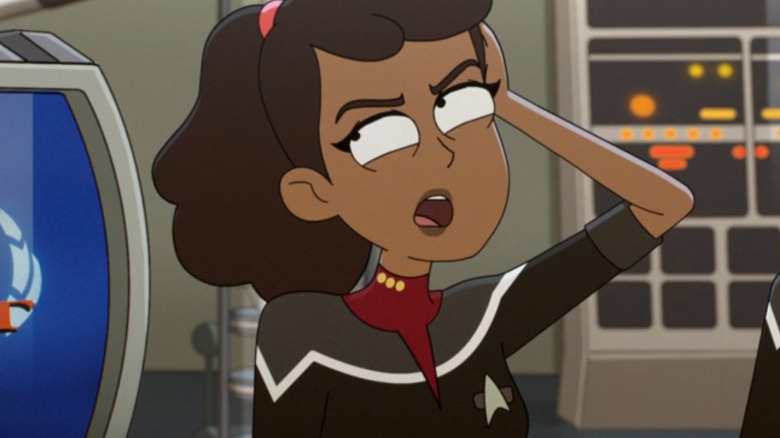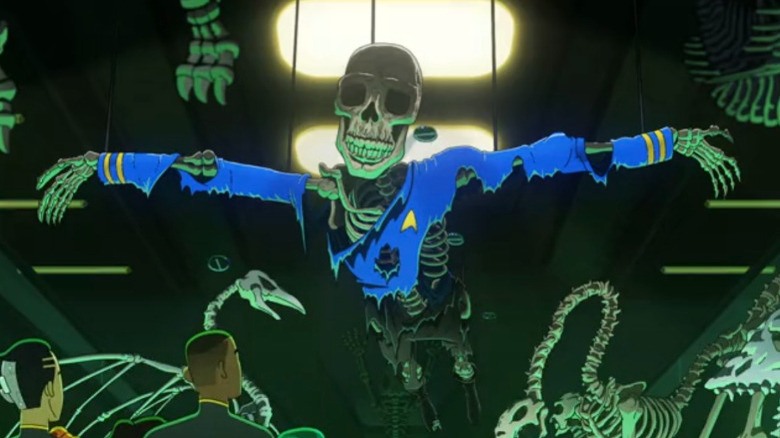Why Star Trek: Lower Decks Isn't Worried About Franchise Canon
When you have a lot of episodes of a TV series, and you have a lot of TV series that all have a lot of episodes, and you also have a lot of books and comic books and video games and movies, and they're all telling stories in the same world and about the same people, there's a word that's going to come up sooner than later. And that word is "canon."
"Canon" is sometimes used synonymously with "continuity," the idea that stories should remain consistent in their depiction of events, characters, and information so as not to break the illusion of reality they collectively create. But canon goes beyond that. Canon is supposed to be official. It literally was created to describe religious texts, in reference to dogmatic and holy scriptures. So in the realm of a fictional universe, canon is supposed to be something that is definitely real to the characters, definitely happened in a specific way, and as a result, all other stories have to acknowledge that canon or, at the very least, never negate it.
"Star Trek" has been around for nearly 60 years. It's a continuing story that plays out across a wide variety of media, and in order to keep all that continuity straight, it has developed its own canon over the years. Some events have been rewritten, but some are set in stone, and new "Star Trek" TV shows have to consider that canon before they tell any of their new stories.
Except "Star Trek: Lower Decks," apparently. It turns out that series (almost) has a free pass.
Canon-tinuity?
"Lower Decks" is an animated series set shortly after the events of the live-action series "Star Trek: The Next Generation" and its 1990s spin-offs, "Deep Space Nine" and "Voyager." Where most "Star Trek" shows either embrace a serious tone or an episodic structure, one in which humorous episodes and serious episodes can alternate freely, "Lower Decks" is mostly a comedy series that pokes gentle fun at various story elements and characters from the franchise's multi-decade history.
Since it's animated, and has the freedom to depict aliens and locations free of the practical and budgetary restrictions that prevent live-action "Trek" from doing any type of episode whenever it wants, the makers of "Lower Decks" pack most episodes with storytelling elements and callbacks to previous episodes. Sometimes that means bringing the starship Voyager out of mothballs for an episode of its historical preservation. Sometimes that means throwaway gags about prank calling the slime monster that unceremoniously killed Tasha Yar in the first season of "Star Trek: The Next Generation."
The point is, they can do pretty much whatever they want in terms of referencing previous continuity. "As far as Easter eggs go, there'll be stuff they read in the script that's like, we're in a sci-fi room, it's a museum. There's bones and there's a giant or a giant skeleton, and Spock Two from 'The Animated Series,'" supervising director Barry Kelly told Inverse.
There really seem to be few limits. "In the Voyager episode, for instance, we have the nano-virus, all that stuff, the lizard salamanders, the holograms, all that stuff was written in the script," Kelly added. "But for something like the movie episode, 'Crisis Point 2: Paradoxus,' at the last minute we added this Easter egg of actual live-action overlay of the computer they're looking at in 'The Wrath of Khan.'"
The finite (but large) Vulcan
The thing is, a lot of these shout-outs to previous episodes and films don't exist in a vacuum. The giant Spock skeleton in the "Lower Decks" season 2 episode "Kayshon, His Eyes Open" confirms that not only did Spock's gigantic clone from "The Infinite Vulcan" (a very strange episode of "Star Trek: The Animated Series," written by series regular Walter Koenig no less) meet his demise, but at some point his skeleton was acquired by a rare antiquities collector and put on gruesome display.
That throwaway joke not only adds to "Star Trek" canon, it arguably takes a story option off the table if someone else ever wants to use it. Or does it?
Series co-producer Brad Winters told Inverse that "Lower Decks" is in an unusual place in the franchise, chronologically speaking, which gives it more freedom to be play around with canon:
"All the shows are talking. We don't want to do the same stuff thematically, but we don't have to worry about continuity because we're very separate in the timeline. 'Discovery' is after us. 'Picard' is after us. 'Strange New Worlds' is soooo in front of us."
That means that, by taking place within a pocket of time unexplored by other "Trek" shows — which either take place long before it, long afterwards, or really long afterwards — the makers of "Lower Decks" just don't have to worry about getting in trouble with other shows. Except, of course, when they do.
"We would never do the Gorn," said Winters. Which makes sense, because "Strange New Worlds" is still telling the story of the Gorn, and if "Lower Decks" reveals what the Gorn are doing a century later, it would give the other show's storyline away.
So basically, "Lower Decks" has complete freedom to add to and play with canon... except when it doesn't.


